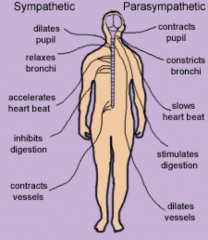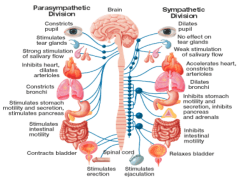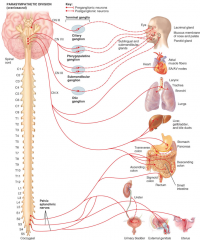![]()
![]()
![]()
Use LEFT and RIGHT arrow keys to navigate between flashcards;
Use UP and DOWN arrow keys to flip the card;
H to show hint;
A reads text to speech;
23 Cards in this Set
- Front
- Back
|
The Autonomic Nervous System |
The name originates from the idea that the system operates in a self –governing or autonomous way |
|
|
REVIEW OF THE NERVOUS SYSTEM Divided into two subsystems |
The Central Nervous System CNS Brain & spinal cord The Peripheral Nervous System PNS Somatic (Voluntary) Autonomic (Involuntary) |
|
|
SOMATIC NERVOUS SYSTEM |
The somatic nervous system (voluntary) contains both sensory and motor neurons. The sensory division contains neurons which convey information from the senses – such as taste and smell The motor division contains neurons which innervate skeletal muscle to produce conscious, voluntary movements. |
|
|
AUTONOMIC NERVOUS SYSTEM |
The autonomic motor neurons regulate visceral activities by either increasing (exciting) or decreasing (inhibiting) ongoing activity. They act upon cardiac muscle smooth muscle, glands. Most autonomic responses can not be consciously altered or suppressed. |
|
|
Function of the ANS |
The function of the ANS is to maintain the bodies internal environment -HOMEOSTASIS. The ANS usually operates without conscious control. The ANS is regulated by the hypothalamus and medulla oblongata When things go wrong you body tends to experience abnormal activity |
|
|
What does the ANS control? |
Helps to control the heart rate blood pressure digestion respiration blood pH These controls are done automatically -below the conscious level |
|
|
Reflex arks |
The Autonomic Nervous System (ANS) operates via Reflex Arcs The Reflex Arc is an automatic, involuntary reaction to a stimulus i.e. the response not being consciously controlled. Can be Somatic or Autonomic Example of a somatic reflex arc is:-knee jumping after being tapped with a rubber hammer. |
|
|
Receptors |
A structure that monitors changes in a controlled condition. Sends an input (nerve/chemical) to the control centre. Baroreceptors -pressure receptors Chemoreceptors-monitor pH, Oxygen and other chemical levels Proprioreceptors-monitor physical activity. Thermoreceptors-monitor temperature changes. |
|
|
Effectors |
A body structure that receives inputs (nerve /chemical signals) from the control centre and produces a response or effect that changes the controlled condition. Examples Heart Skin Sweat glands |
|
|
The Autonomic Nervous System ANS (involuntary) is Further Subdivided |
Sympathetic division Parasympathetic division |
|
|
ANS Devisions |
The two divisions of the ANS tend to have opposing actions (antagonistic) and differ in structure Organs that receive impulses from both sympathetic and parasympathetic fibers are said to have DUAL INNERVATION |
|
|
The Devisions Excites or inhibits Smooth muscle Cardiac Muscle Glands |

|
|
|
Sympathetic Parasympathetic |

|
|
|
Sympathetic Parasympathetic |

|
|
|
Sympathetic Responses |
usually is caused by physical or emotional stress - “E situations” emergency, embarrassment, excitement, exercise |
|
|
Sympathetic Responses |
Alarm reaction = flight or fight response dilation of pupils increase of heart rate, force of contraction & BPdecrease in blood flow to nonessential organs increase in blood flow to skeletal & cardiac muscle airways dilate & respiratory rate increases blood glucose level increase |
|
|
Parasympathetic Responses |
Enhances “rest-and-digest” activities Mechanisms that help conserve and restore body energy Normally dominates over sympathetic impulses SLUDD salivation, lacrimation, urination, digestion & defecation The 3 “decreases”- Decreased Heart Rate, Decreased Diameter of airways Decreased Diameter of pupil |
|
|
Physiological Effects of the ANS |
Most body organs receive dual innervationinnervation by both sympathetic & parasympathetic Hypothalamus regulates balance (tone) between sympathetic and parasympathetic activity levels Some organs have only sympathetic innervationsweat glands, adrenal medulla, erector pili & many blood vessels |
|
|
DIVISIONS OF THE ANSSYMPATHETIC |

|
|
|
PARASYMPATHETIC DIVISIONS |

Cranial Supply 4 cranial nerve in brainstem SacralInnervate smooth muscle and glands in colon, ureters, bladder & reproductive organsSplanchnic nerve |
|
|
4 x Parasympathetic Cranial Nerves |
Oculomotor nerve ciliary ganglion in orbit ciliary muscle & pupillary constrictor muscle inside eyeball Facial nerve pterygopalatine and submandibular ganglions supply tears, salivary & nasal secretions Glossopharyngeal otic ganglion supplies parotid salivary gland Vagus nerve many functions including effecting heart rate, pulmonary activity and GI tract as far as the midpoint of the colon |
|
|
DISORDERS -Reynauds |
Raynaud’s phenomenon is due to excessive sympathetic stimulation of smooth muscle in the arterioles of the fingers as a result the digits become ischemic after exposure to cold or with emotional stress. |
|
|
Disorders -Horners syndrome |
In Horner’s syndrome, the sympathetic innervation to one side of the face is lost. Horner's syndrome is characterized by an interruption of the sympathetic nerve pathway somewhere between its origin in the hypothalamus and the eye NB Not to be confused with Bell’s Palsy |

